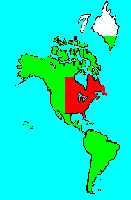SPECIES INFO
Bluegill (Lepomis macrochirus) was originally found from New York to Minnesota and south to Florida and Texas. However, this fish has been introduced widely in the United States and in other countries. Although records say this fish can be up to 16 inches in length, most examples are much smaller than that.
Rohde etal in their book on freshwater fishes of the Carolina-Virginia area note this species is abundant in their area, but absent from cold mountain areas.
Pflieger in his 1975 book on Missouri fishes notes the bluegill is the most common sunfish in man made bodies of water.
The Siglers note in their book on Utah fishes that populations of bluegills now exist in Utah. They note bluegills frequently provide good forage for large mouth bass.Lepomis genus, Bluegill and sunfish, originated in North America, primarily east of the Rocky Mountains, but the genus is also naturally found as far west as New Mexico and Mexico. There are 11 species in this genus. All are rather flat fish with a somewhat round outline. These are frequently referred to as panfish, as when cleaned they easily fit into a frying pan.
Sunfish and Bass group, Family Centrarchidae, is a group of fish that naturally inhabited North America. Because of their great popularity as a sport fish group, many of the species have
been introduced worldwide with varying degrees of success. There are about 30 species in this family. The crappies, bluegill, and black bass belong here.
Perch-like Fish, Order Perciformes, are the largest order of fish in both freshwater and shallow saltwater. Most of the conventional fish belong to this order. The bass, bluegills, perch and crappies of freshwater plus the groupers and sea bass of salt water belong to this order. The fish all have spiny rays in their fins and the tail fin has seventeen rays. There are approximately 150 families. Herein, we have placed the families in alphabetical sequence within this order. (In some instances the typical taxonomic sequence of families is not much help. Consider, for example, that the barracudas are usually placed between the mullets and the threadfins.)
Bony fish, Class Teleostomi, are a class of chordates that include the majority of fish-like animals found on earth. They are characterized by a bony jaw and a bony skeleton. They are found in both fresh and marine waters.
Backboned Animals (Phylum Chordata) are the most advanced group of animals on earth. These animals are characterized by having a spinal cord or backbone. Most members have a clearly defined brain that controls the organism through a spinal cord. Fish, amphibians, reptiles, birds, and mammals are in this phylum.
Currently, some taxonomists believe that the fish should be divided into two groups (sharks and regular fishes) and that there are some other primitive groups in the phylum such as hagfish or lampreys.
Animal Kingdom contains numerous organisms that feed on other animals or plants. Included in the animal kingdom are the lower marine invertebrates such as sponges and corals, the jointed legged animals such as insects and spiders, and the backboned animals such as fish, amphibians, reptiles, birds, and mammals.








